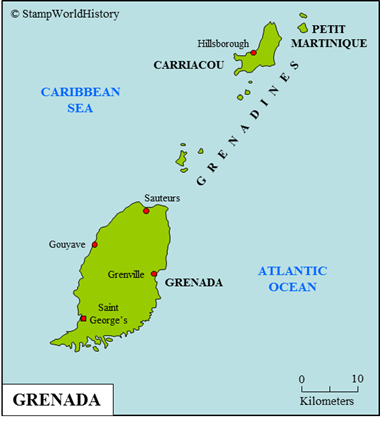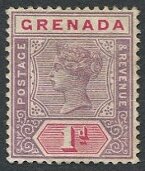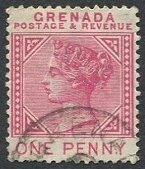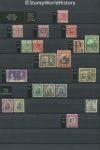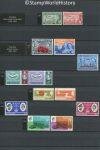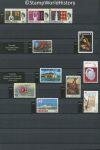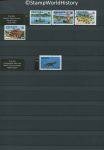
Grenada
British colony

Grenada
Independent
Quick reference
General issues: British colony 1861-1958, Province West Indies Federation 1958-1962, British colony 1962-1967, Associated state 1967-1974, Independent within the British Commonwealth 1974-1979, People’s Revolutionary Government 1979-1983, Independent within the British Commonwealth 1983-Present
Country name on general issues: Grenada
Special issues: Regional issues Grenadines of Grenada 1973-2000, Carriacou & Petit Martinique 2000-Present
Currency: 1 Pound – 20 Shilling, 1 Shilling = 12 Pence 1861-1949, 1 Dollar = 100 Cent 1949-Present
Population: 62 000 in 1900, 109 500 in 2012
Political history Grenada
Grenada is an island country located in the Caribbean as part of the Lesser Antilles – for the exact location, please refer to the map of the Caribbean. The country comprises the main island of Grenada and the southern part of the Grenadines – the northern part of the Grenadines belonging to Saint Vincent. Prior to colonization, Grenada was inhabited by the Amerindian Carib people – a people found on many of the Lesser Antilles. The first European to sight Grenada was Christoper Columbus on his third voyage in 1498. The Carib warded off European settlement until 1650 when the French established the first permanent European settlement. Grenada would be a French colony until 1762 when the British took possession the island. The French regained Grenada in 1779, but, in 1783, British sovereignty was finally recognized by the French.
Once established as a British colony, Grenada was, in 1833, made part of the Windward Islands colony – the federal colony that grouped together the British possessions in the Windward Islands. Grenada became the seat of the governor of the Windward Islands in 1885. The Windward Islands colony was – unlike the Leeward Islands – a loose federation in which the constituent parts had their own parliaments and legislation. The Windward Islands colony was dissolved in 1956. Shortly after, between 1958 and 1962, Grenada joined the West Indies Federation – a short lived federation of most of the British possessions in the Caribbean. In 1967, Grenada became self governing as an associated state, and in 1974 Grenada gained full independence within the British Commonwealth.
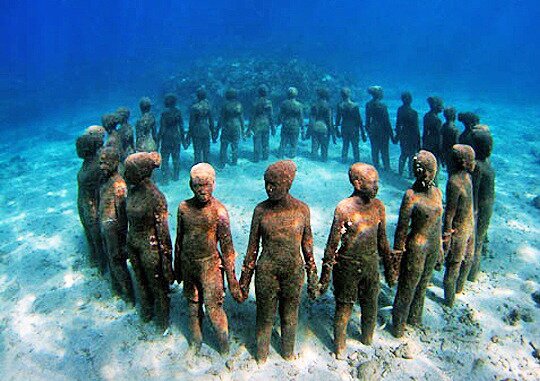
Grenada is home to a unique underwater sculpture park. Although not intended as such by the artist who made the sculptures, the park has come to be seen a monument for slaves thrown overboard on the passage to the Americas.
In 1979, a coalition of political parties staged a coup and formed the socialist oriented People’s Revolutionary Government – the PRG. A further coup in 1983 brought the military to power, intent on imposing more radical socialist policies than the PRG had done. The coup was reason for the United States to intervene. The United Sates was supported by a number of Caribbean nations. Constitutional government was restored and Grenada is a stable parliamentary democracy since then.
Economically, Grenada was developed as a plantations colony, first by the French and later by the British. Sugar cane was the most important crop. To man the plantations, slaves were brought from Africa who would soon outnumber the planters of European descent. When the production of sugar cane declined in the 19th century, new crops were developed – cocoa, bananas, mace and nutmeg. Grenada currently produces 40% of the world’s nutmeg. In the 20th century tourism was developed. Currently, agriculture and tourism are the most important sectors in the economy. The majority of the population of Grenada is black – 89% – with a large minority of people of mixed descent – 8%. Grenada is the main island of the country and is home to the vast majority of the population – 88 200 in 2002. The inhabited Grenadines – Carriacou and Petit Martinique – counted a population of 5 600 in 2002.
Postal history Grenada
The first stamps used in Grenada were the general issues of Great Britain. These were used between 1858 and 1860. Grenada issued its first stamps in 1861 – showing the portrait of Queen Victoria in a design called the ‘Chalon Head’, a design also used in a limited number of other British colonies.[1]For more about the ‘Chalon Heads’, please refer to the profile of Nova Scotia. In 1883 and 1887, stamps were issued with the portrait of Queen Victoria in the design that is probably the most commonly used in the British colonies – the frame, however, is specific for Grenada. In 1895, stamps were issued with the same portrait – the frame now being the frame most commonly used in the British colonies. Further issues in the classical period are a blend of designs common to the British colonies and specific for Grenada.
In the modern period Grenada has issued large numbers of stamps aimed at the thematic collectors market. Reflecting the political developments, the PRG issued a set of overprints in 1980 on the first anniversary of the establishment of the PRG – the overprint reading ‘People’s Revolution 13 March 1979’. From 1973, stamps were also issued for the Grenadines of Grenada – called Carriacou & Petit Martinique from 2002. Again, stamps aimed at the thematic collectors market. In fact, Grenada ranks at the top of the list of countries that issued the most stamps in the world between 1980 and 2012. For more about ‘runaway stamp production’, please refer to the profile of Saint Vincent.
Album pages
← Previous page: French GuianaNext page: Guadeloupe →

